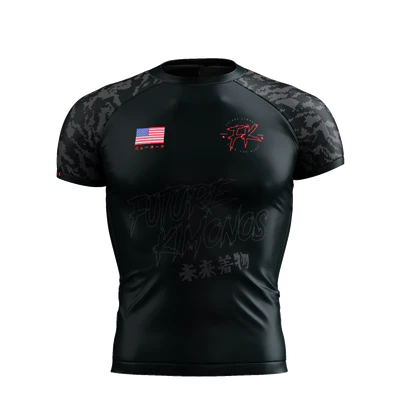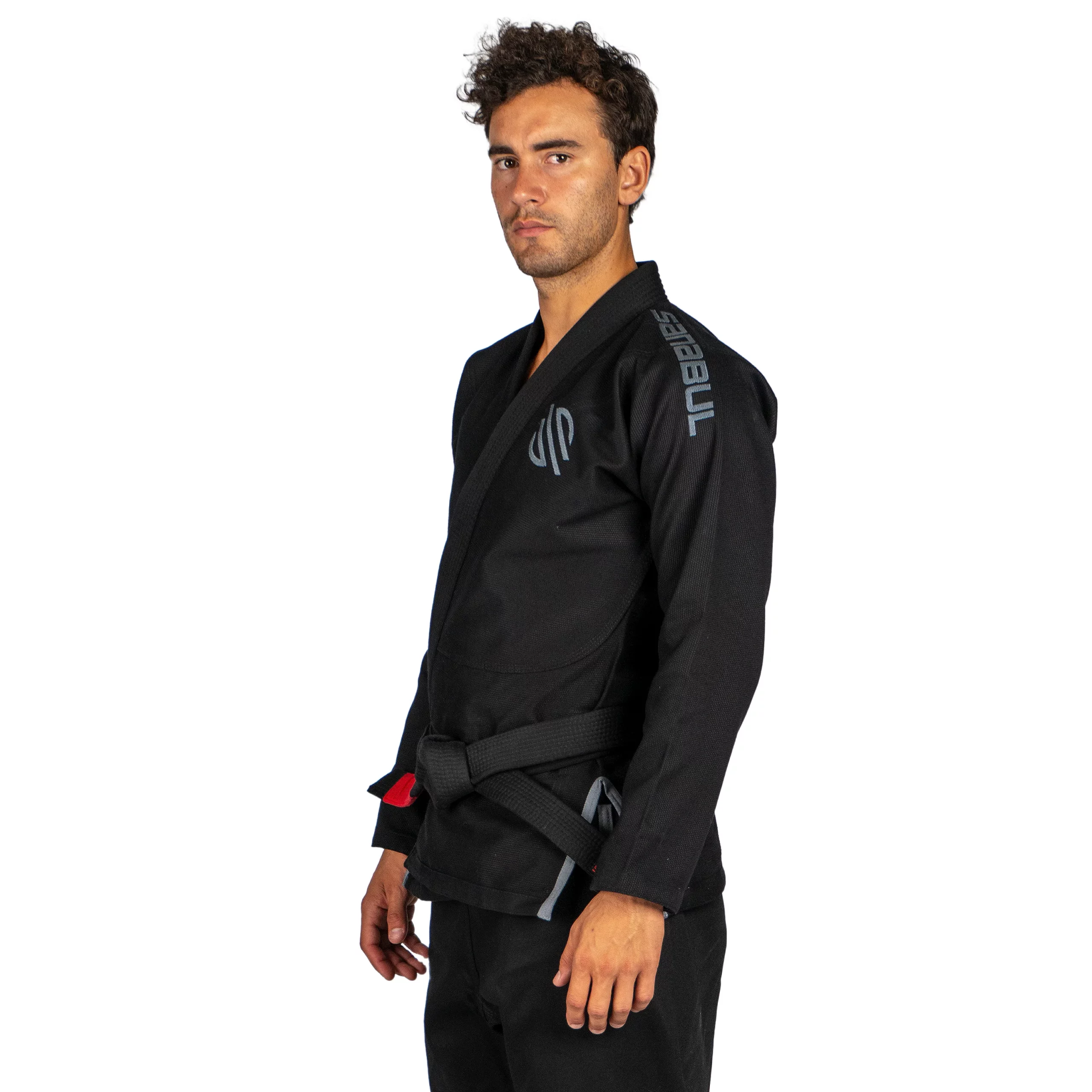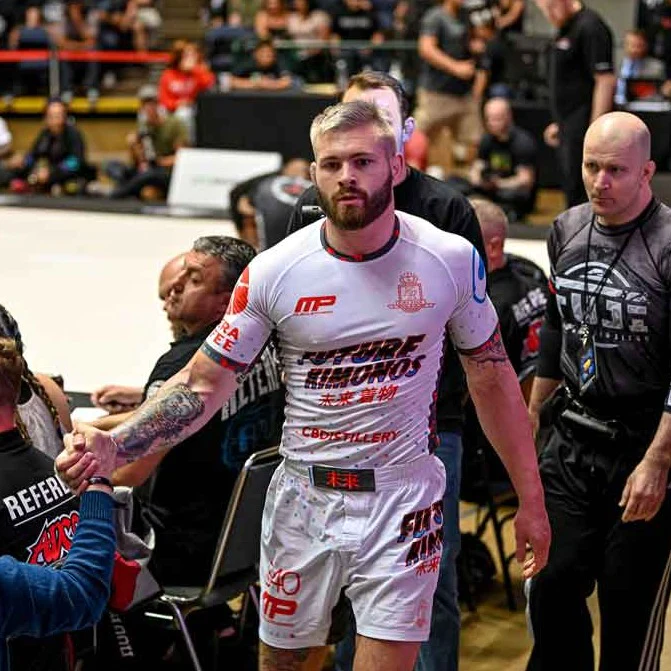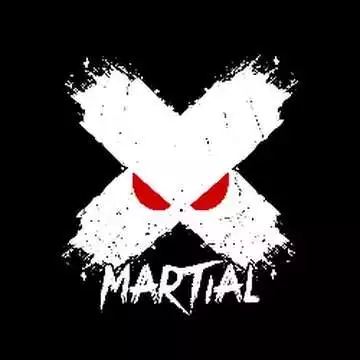
Cameron
Table of Contents
Yes, just like other combat sports (MMA, Boxing, Muay Thai) Brazilian jiu-jitsu has weight classes. In this article, we will take a deeper look at the BJJ weight classes for men, women, and children that compete in the sport.

BJJ Weight Class General Information
Weight classes in Brazilian jiu-jitsu are necessary for a number of reasons. Just like in all combat sports, weight classes are necessary to keep the competition fair ad even to the best degree possible. A trained individual that outweighs another trained individual has a significant advantage over the undersized opponent.
Understanding this simple concept, competition organizers like the ADCC, JJWL, AZBJJL, Grappling Industries, and IBJJF (International Brazilian jiu-jitsu federation) came up with a systemized way for people to compete with those in a similar weight bracket.
This article will be updated frequently to provide you with the most up-to-date information. Most of the time the weight classes will not change much.

Men’s Divisions
Men Gi (Adults & Masters Division)
Out of all the IBJJF weight classes for adult males, the lightest weight class is the Rooster which has a limit of 57.5 kilograms or 126.5 pounds. The weight divisions are the following:
-
Rooster – (anyone under 57.5 kg or 127 lbs)
-
Light Feather – (between 127.5lbs and 64 kg or 141.6 lbs)
-
Feather – (between 142lbs and 70 kg or 154 lbs)
-
Light – (between 155 lbs and 76 kg or 167 lbs)
-
Middle – (between 168.1 lbs and 82.3 kg or 181 lbs)
-
Medium Heavy – (between 181.7 lbs and 88.3 kg or 195 lbs)
-
Heavy – (between 195.1 lbs and 94.3 kg or 208 lbs)
-
Super Heavy – (between 208.1 lbs and 97.5 kg or 222 lbs)
-
Ultra Heavy – (anything over 222 lbs)
There’s also the Open Class in which competitors of all weights can compete against one another without any weight restrictions.
Men NoGi (Adults & Masters Division)
We start the No Gi weight classes with the adult males and masters categories. The lightest of the weight divisions allows athletes to weigh up to 51.5 kilograms or 114 lbs. The classes are the following:
-
Rooster – (anything below the weight of 122.6 lbs)
-
Light Feather – (between 122.7 lbs and 136 lbs)
-
Feather – (between 136.1 lbs and 149 lbs)
-
Light – (between 149.1 lbs and 162.6 lbs)
-
Middle – (between 162.7 lbs and 175.6 lbs)
-
Medium Heavy – (between 175.7 lbs and 188.6 lbs)
-
Heavy – (between 188.7lbs and 202 lbs)
-
Super-Heavy – (between 202.1 lbs and 215 lbs)
-
Ultra Heavy – (anyone over 215.1 lbs with no maximum limit)
Find top-rated rash guards here
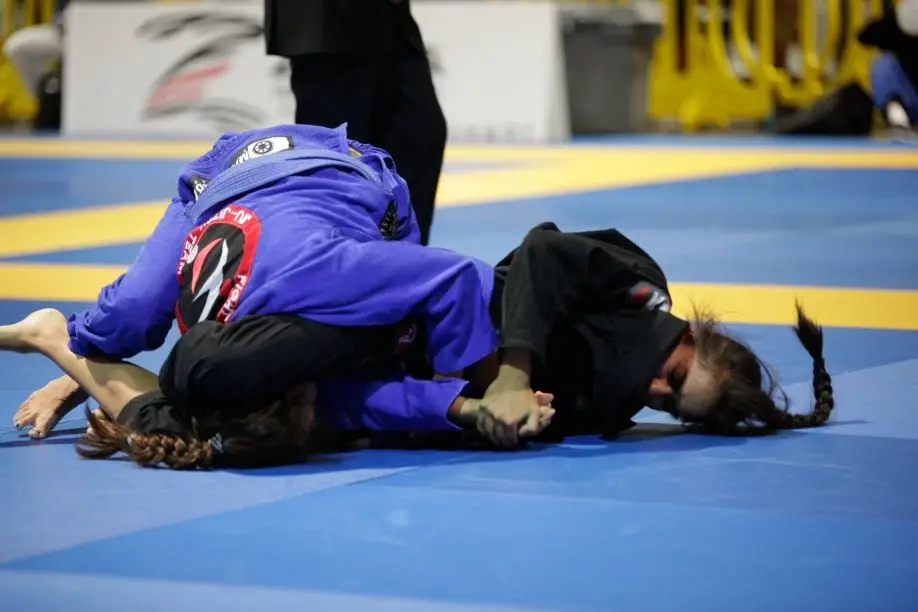
Women’s Divisions
Women Gi ( Adults & Masters Division)
The lightest weight division for female Gi competitors is the Rooster with an upwards weight limit of 47.5 kilograms or 107 pounds. You also have an open weight class where anything goes.
-
Rooster – (anything up to 107 lbs or 47.5 kg)
-
Light Feather – (between 107.1 lbs and 118 lbs or 53.5 kg)
-
Feather – (between 118.1 lbs and 129.0 lbs or 58.5 kg)
-
Light – (between 129.1 and 141.6 lbs or 64.2 kg)
-
Middle – (between 141.7 lbs and 152.6 lbs or 69.2 kg)
-
Medium Heavy – (between 152.7 lbs and 163.6 lbs or 74.2 kg)
-
Heavy – (between 163.7 lbs and 175 lbs or 79.3)
-
Super Heavy – (anything over 175 lbs with no maximum limit)
Women No Gi ( Adults & Masters Division)
The adult female No Gi weight classes are as shown below. The lightest weight division allows up to 42.5 kilograms or 94 pounds.
-
Rooster – (anything below the weight of 103 lbs)
-
Light Feather – (between 103.1 lbs and 114 lbs)
-
Feather – (between 114.1 lbs and 125 lbs)
-
Light – (between 125.1 lbs and 136 lbs)
-
Middle – (between 136.1 lbs and 147 lbs)
-
Medium Heavy – (between 147.1 lbs and 158 lbs)
-
Heavy – (between 158.1 lbs and 169 lbs)
-
Super-Heavy – (anyone over 169.1 lbs with no maximum limit)
Find top-rated rash guards here
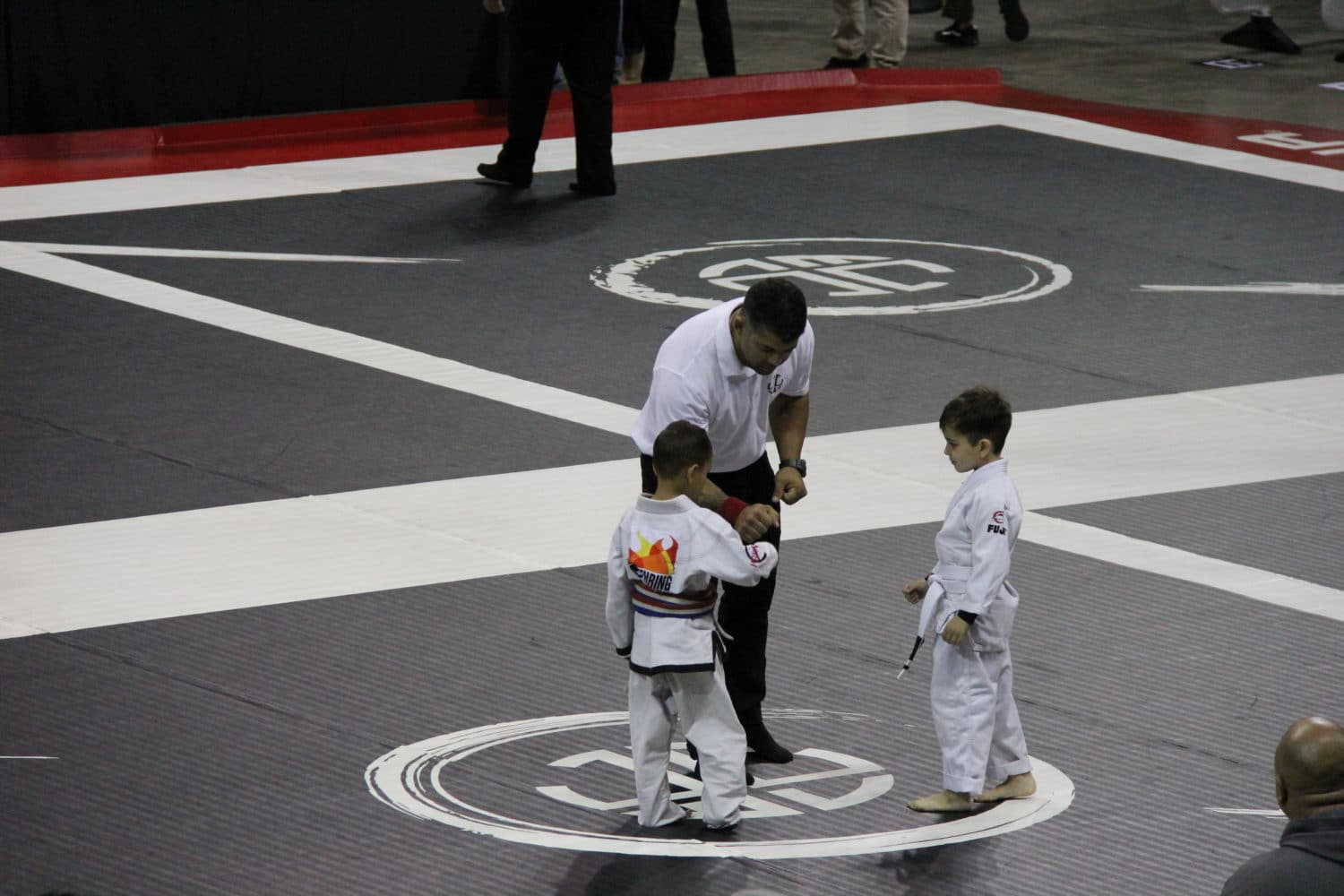
Kids Divisions
Juvenile IBJJF Female Gi Weight Classes
The juvenile females’ Gi weight classes are shown below:
-
Rooster – (anyone below 98 lbs)
-
Light Feather – (between 98.1 lbs and 106.6 lbs)
-
Feather – (between 106.7 and 116 lbs)
-
Light – (between 116.1lbs and 125 lbs)
-
Middle – (between 125.1 lbs and 133.6 lbs)
-
Medium Heavy – (between 133.7 lbs and 143.6 lbs)
-
Heavy – (between 143.7 lbs and 152 lbs)
-
Super Heavy – (anyone above 152.1 lbs with no maximum limit)
Juvenile IBJJF Female No Gi Weight Classes
Someone who competes in the juvenile weight classes is considered to be under the age of 16 and has a belt going with the kid’s system in place. Just like the juvenile boys division, the juvenile female’s division is broken down in two categories most likely in relation to age but the weight classes stay the same. The juvenile females’ Gi weight classes are shown below; there’s an open weight class as well:
-
Rooster – (anyone below 94 lbs)
-
Light Feather – (between 94.1 lbs and 103 lbs)
-
Feather – (between 103.1 and 111.6 lbs)
-
Light – (between 111.7 lbs and 120.6 lbs)
-
Middle – (between 120.7 lbs and 129 lbs)
-
Medium Heavy – (between 129.1 lbs and 138 lbs)
-
Heavy – (between 138.1 lbs and 147 lbs)
-
Super Heavy – (anyone above 147.1 lbs with no maximum limit)
Just What You Need. We designed the Sanabul Essential Jiu-Jitsu Gi to set a high bar for what you can expect from a BJJ gi whether this is your first Jiu Jitsu gi or an addition to your current line up. Quality construction, clean design, and incredible value make this Brazilian Jiu Jitsu gi the #1 Best Seller in the industry
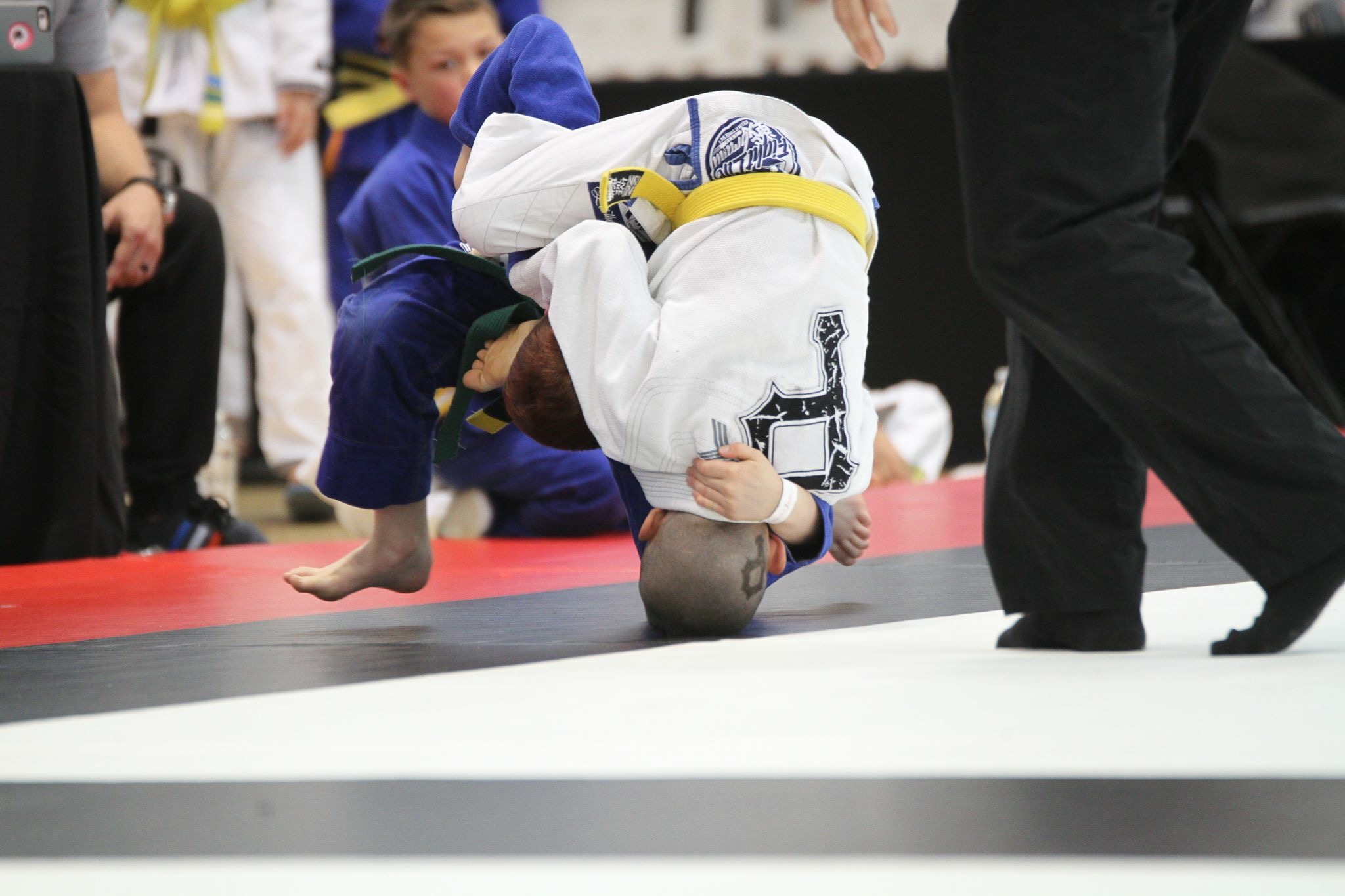
Juvenile IBJJF Male Gi Weight Classes
Someone who competes in the juvenile weight classes is considered to be under the age of 16 and has a belt going with the kid’s system in place. The Juvenile Gi weight classes for boys are the following:
-
Rooster – (anything below the weight of 118 lbs or 53.5 kg)
-
Light Feather – (between 118.1 lbs and 129 lbs or 58.5 kg)
-
Feather – (between 129.1 lbs and 141.6 lbs or 64 kg)
-
Light – (between 141.7 lbs and 152.6 lbs or 69.2 kg)
-
Middle – (between 152.7 lbs and 163.6 lbs or 74 kg)
-
Medium Heavy – (between 163.7 lbs and 175 lbs or 79.3 kg)
-
Heavy – (between 175.1 lbs and 186 lbs or 84.3 kg)
-
Super Heavy – (between 186.1 lbs and 197 lbs or 89.3 kg)
-
Ultra Heavy – ( anything above 197lbs with no maximum limit)
Juvenile IBJJF Male No Gi Weight Classes
Someone who competes in the juvenile weight classes is considered to be under the age of 16 and has a belt going with the kid’s system in place. The juvenile male division has two separate categories probably based on age so please refer to the table below for an accurate representation of where you will be placed in this upcoming tournament! The Juvenile Gi weight classes for boys are the following (see the most left column):
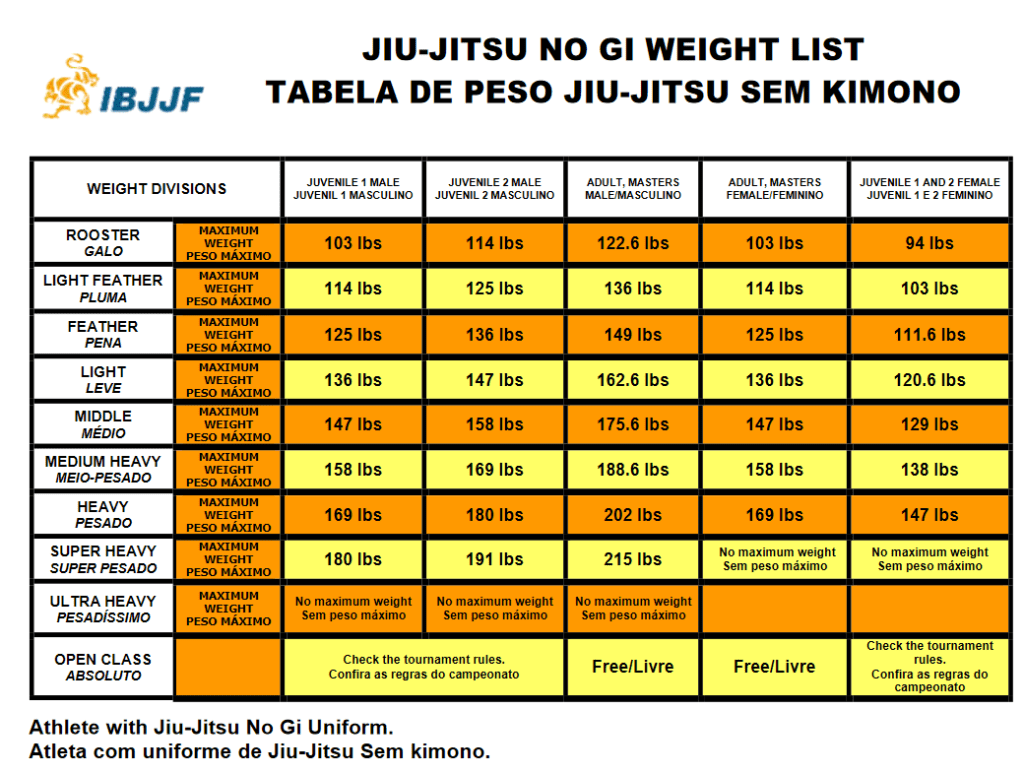
IBJJF Age Divisions
In addition to weight classes, IBJJF has a few age divisions that separate competitors. The age divisions are separated into three categories juvenile, Adult, and Masters division.
-
Juvenile I – This for 16 to 17 year old or younger
-
Juvenile II – For 17 and 18-year-olds
-
Adults – 18 is the minimum age, with no max age limit
-
Masters – 30+ (6 age ranges)
Find the top-rated BJJ Gi's here. Helpful information on what to look for, how to find the best gi, and which brands suit you best based on your budget!
Masters Division Breakdown
-
Master 1 – 30-35 years.
-
Master 2 – 36 to 40 years
-
Master 3 – 41 to 45 years
-
Master 4 – 46 to 50 years
-
Master 5 – 51 to 55 years
-
Master 6 – 56 to 60 years+
Adults and Masters Age Divisions and Match Length (IBJJF)
Matches are typically 5 minutes long depending on the tournament and the stakes that are at hand. Matches will go into overtime if needed for a large-scale tournament but in regional or local tournaments they may decide the winner based on advantage points.
Weighing in at IBJJF Competitions
Weigh-ins for IBJJF tournaments (similar to ADCC and most other tournament formats) will happen right before your match. Typically when your match is two fights away you will be called in for official weigh-ins and you must make weight in order to compete.
Designed in line with the latest sport science and nutrition research to help you perform and feel your best. Every formula is critiqued and revised in accordance with feedback from independent scientific advisors to ensure proper efficiency.
Weighing in for Gi Tournaments
A couple of IBJJF rules must be followed during a weigh-in. Whether it is a No Gi or Gi competition, the athlete must be in proper uniform while on the scale. If they fail to make the required weight, they’ll be disqualified.
There are no second chances offered and the competitor won’t be able to switch weight classes. They won’t be given a refund either.
How Much Does a Gi Weigh?
A Gi can weigh as much as 0.9 kg (~2 lbs) or as high as 2.26 kg (~5 lbs). This is why Gi competitions have slightly higher weight limits as compared to No Gi contests – to compensate for the added weight.
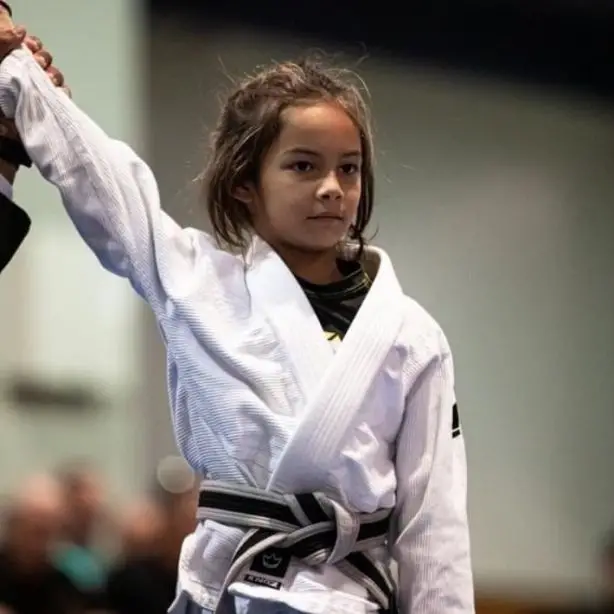
IBJJF Uniform Rules
What is IBJJF-CERTIFIED Gi?
An IBJJF Certified Gi is a Brazilian Jiu-Jitsu uniform that meets the standards and requirements set by the International Brazilian Jiu-Jitsu Federation (IBJJF) for use in competition. As we have covered before, the IBJJF is the Brazilian Jiu-Jitsu community’s largest and most prestigious governing body. Their job is to keep BJJ regulated and set standards for competition Gi’s, promotions, and even substance abuse policies (source).
A Brazilian Jiu-Jitsu Gi that is certified as a competition gi is made with the correct materials and is constructed properly. The measurements of how the Gi fits on the athlete are proper for fair play.
An IBJJF-certified Gi must meet these criteria:
-
Fabric Weight: The gi must weight no more than 1.5 kg (3.3 lbs) for adults and 1.2 kg (2.6 lbs) for kids.
-
Weave: Juvenile, adult, and master division competitions require a gi with a pearl weave
-
Design: The color of the gi must be completely white, black, or royal blue. Any other colors are not allowed. In IBJJF tournaments competitors are not allowed to wear undershirts under their Gi, except for women. Females can wear any color undershirt.
-
Fit: The gi top can extend to the thigh of the competitor and the sleeves are allowed to be at max, 5 cm from the competitor’s wrist when the arm is parallel to the ground and extended straight out. Gi pants are allowed to be at max 5 cm above the ankle bone. Spats are not allowed under gi pants for male competitors.
-
Material: Gi’s must be tailored using cotton or a similar fabric. The fabric cannot be too thick or too hard that it prevents an opponent from gripping it.
Just What You Need. We designed the Sanabul Essential Jiu-Jitsu Gi to set a high bar for what you can expect from a BJJ gi whether this is your first Jiu Jitsu gi or an addition to your current line up. Quality construction, clean design, and incredible value make this Brazilian Jiu Jitsu gi the #1 Best Seller in the industry
Brazilian Jiu-Jitsu Competition Checklist
-
Make sure to have your Gi and an extra one just in case
-
A snack
-
Water or a drink
-
Wear Slides or sandals
-
Reliable jiu-jitsu bag
-
Headphones (if you want to drown out the notice before your match)
How can I see the weight classes for my specific competition?
Almost every time you go out and compete you will be able to access the exact weight class that you will be fighting in from the competition organizer’s website. We have reliable information here on our blog but we may not be able to catch all minor changes that may occur along the way.
We do our best to keep things fresh and up-to-date here so you can rely on us for future questions but there is a slight chance we may gloss over it. Most of the time tournament rules do not really change and the difference in weight classes is nothing but a couple of pounds or less.
Food and Drink before your Match
When you are competing you may have an anxious feeling before stepping onto the mats. This is normal, it is your body’s reaction to preparation for a fight. Eating something that is light and nutritious while you wait is advised. Have a protein bar or maybe an apple with some kind of drink that will provide you with electrolytes.
Worn in the harshest of competition environments by the absolute best in the business, our gear is proven to withstand the ultimate in training and competition use. Use code 'GRAPPLERSGRAVEYARD' to save 15% on your entire purchase
- Quality Material
- Grade-A Designs
- Comfortable Fitting with Long Shelf Life
Abu Dhabi Combat Club (ADCC) weight classes
Abu Dhabi Combat Club (ADCC) is the world’s largest no-gi grappling tournament and haswith been one of the mian reasons why no-gi grappling has been put on the map. Everyone wants a shot at competing in this tournament and to do so you have to prove that you can hang with the best in the world.
Abu Dhabi Combat Club (ADCC) hosts the world’s best fighters in a single-elimination tournament every two years with the last tournament being in 2022. Both men and women in their respective weight classes will battle it out to determine who is at the top and have bragging rights as to who is the best competitor in the world.
The ADCC World Submission Fighting Championships were the idea and creation of UAW national Sheik Tahnoon Bin Zayed Al Nahyan, the son of the UAE leader Sheik Zayed. Sheik Tahnoon grew a passion for MMA in 1993 and shortly after started training Brazilian Jiu-Jitsu. Sheik Tanoon set out to create and build his vision of implementing martial arts in the UAE and creating a standard around the world for which grappling is measured!
Due to the popularity of the Super Bowl for Jiu-Jitsu (ADCC) the organization has made more widely available sub-tournaments across the United States. All these tournaments fill the gap to the main event that will happen again in 2024 (around September).
Here are the weight classes for ADCC:
Worlds Weight Classes Male and Female
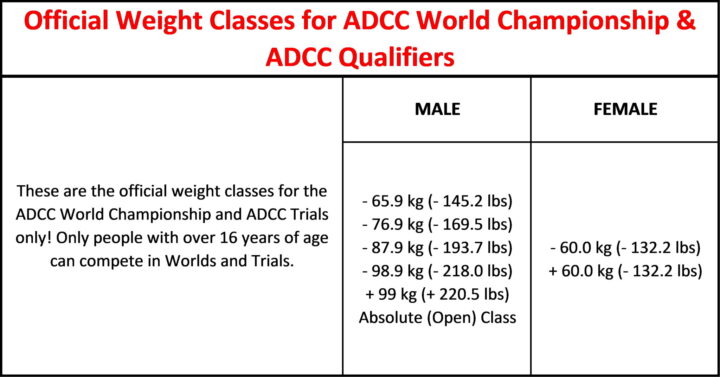
Female Weight Classes – Regional Tournaments
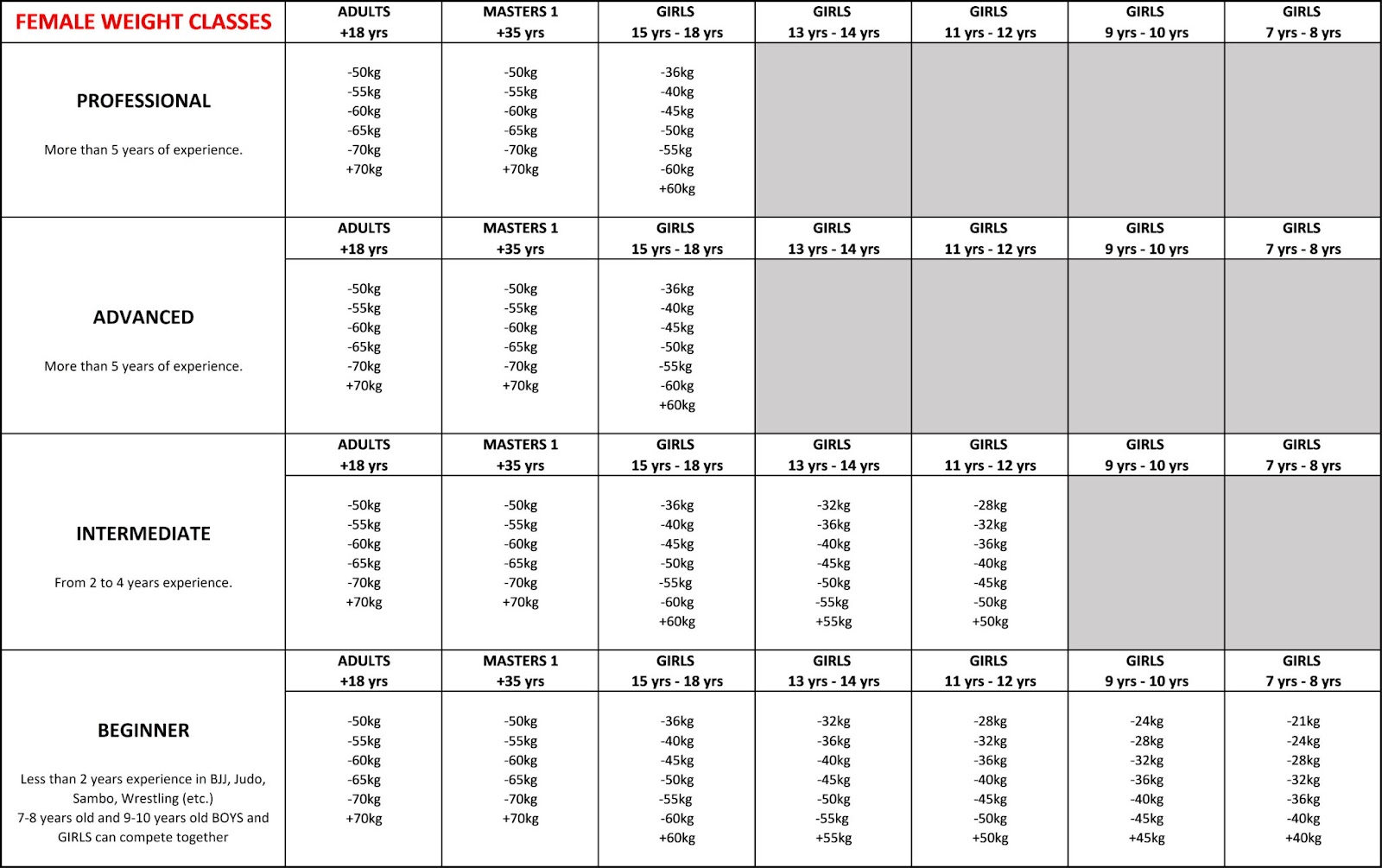
source: ADCC
Use code 'GRAPPLERSGRAVEYARD' for 15% off your entire order
- High Quality Material
- Comfortable and Fits Body Perfectly
- Grade-A Designs
Male Weight Classes – Regional Tournaments
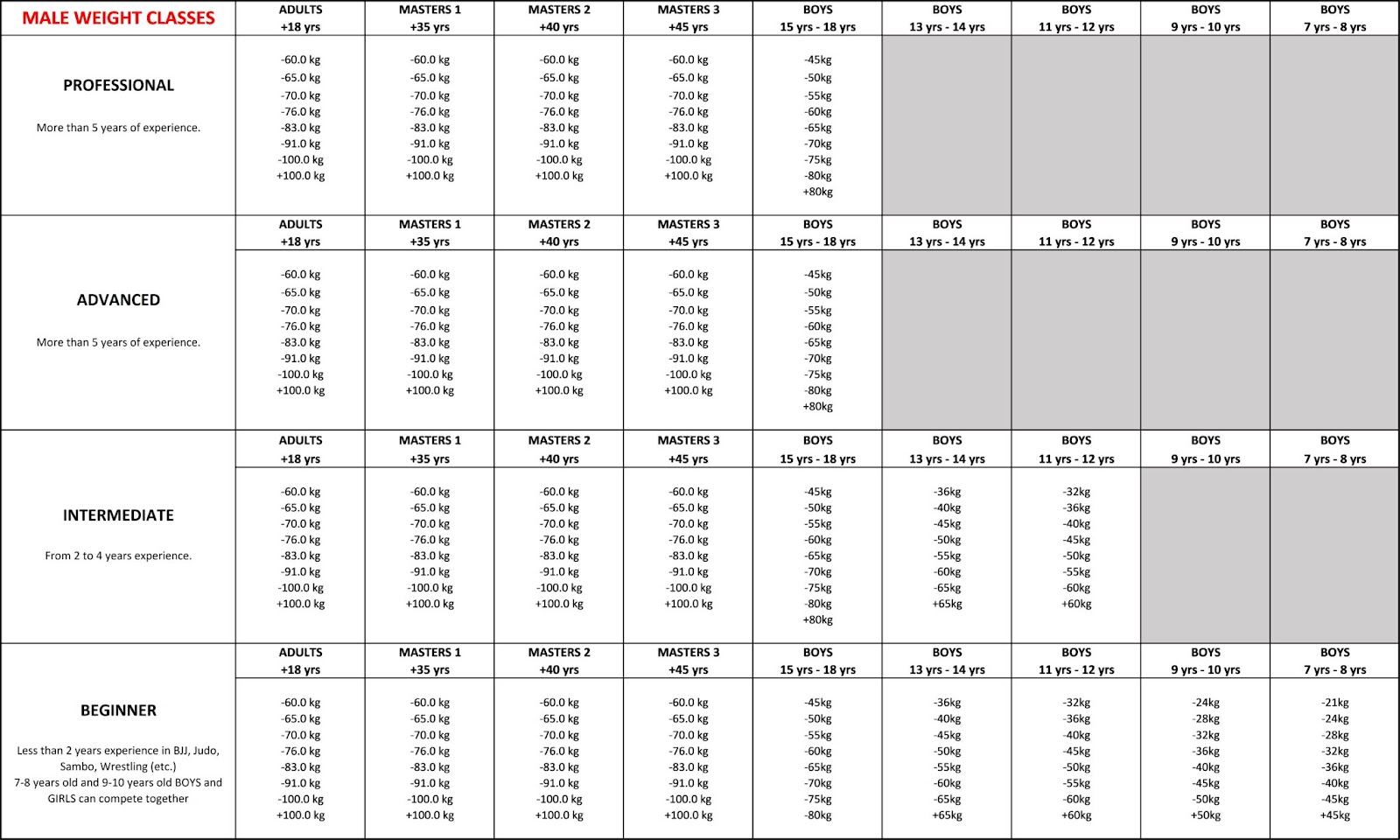
source: ADCC
Weighing in at ADCC Competitions
For ADCC there is one weight-in-place and a scale. A fighter must check their weights before the tournament starts. Fighters must have the following when arriving for their weight in:
-
ID (passport, driver’s license etc.)
-
Receipt of payment for the tournament
-
Equipment must be clean and in good shape
-
Short nails
Fights will be called in two fights in advance for their weigh-in.
Experience success yourself
Competing is something that is not for everyone but it is a great way to put your skills to the test and get a taste of what success feels like. It is a great feeling knowing that you are able to beat someone in fair combat. Although being a high-level competition is not for everyone, we believe you should get a couple of competitive matches under your belt.
Brazilian jiu-jitsu is a sport that breaks down the ego and forces us to level up in a number of ways. When we do not compete out of fear of damaging the ego, it only keeps us from reaching that next level mentally. Who cares if you lose, you are going out and doing something 99% of people will never attempt. What happens if you win? Many possibilities can arise when you start competing but you have to experience this for yourself!
Take the leap!
#1 rated BJJ gear Brand for quality and design. Save 10% on your order using code 'GRAPPLERS'.
Frequently Asked Questions
Are Adults and Masters IBJJF Divisions the Same?
No they are two separate divisions. Adults division is cut off at the age of 29.
When competing in BJJ past the age of 30, you have the option to enter some tournaments in the master divisions. For IBJJF tournaments, they have set up age divisions for the 30+ and over. Master 1 is for athletes aged 30 (or turning 30 in the same year as the competition) to 35, Master 2 is for athletes aged 36 (including) to 40, Master 3 is from 41 to 44, and so on every 5 years.
BJJ Competition Tips
-
Train and feel prepared
-
Eat a light snack that can fuel you
-
Do your best to not have an adrenaline dump (be prepared to have one if not)
Will I get a refund if I don’t make weight?
The norm is that you won’t get a refund if you miss weight. Likely, they won’t allow you to compete at a higher-weight class either. But then again, checking your competition’s rulebook should give you the exact answer.
What age is Master 1 in BJJ?
Master 1 in BJJ is at 30+ years of age.
How much does a gi weigh?
A Gi can weigh as much as 0.9 kg or 5 lbs and as low as 2.26 kg or 2 lbs. This is why Gi competitions have slightly higher weight limits as compared to No Gi contests – to compensate for the added weight.
Is there weight divisions in BJJ?
yes, just like in MMA or other fighting-based martial arts, Brazilian jiu-jitsu competitions have weight divisions.
How do I choose my weight class in BJJ?
Choosing a weight class is easy. Just weigh yourself and see if you are comfortable competing at that weight. If you are not, maybe you can cut a little bit of weight to make it in the weight class below.
Are IBJJF weight classes the same for all the different IBJJF tournaments?
Yes, all IBJJF weight classes are going to be the same. As long as the competition organizer is running on the IBJJF rule set, you will be okay.

